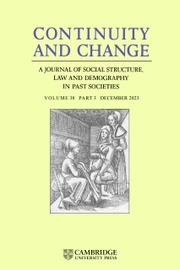The toppling of Bristol slave trader Edward Colston's statue in June 2020 has sparked a raging debate about Britain's historical connections to Atlantic slavery. A renewed scholarly interest in Eric Williams’ famous 1944 thesis that Britain's industrial wealth derived from Atlantic slavery has simultaneously energised research on slave traders, especially the legacies of their investments. Katie Donington's new book, The bonds of family – a family history of the Hibberts, one of Britain's foremost slaving families – has therefore arrived at an opportune moment. Leaving his family roots in the dissenting Manchester weaving community, Thomas Hibbert (1710–1780) struck out to Jamaica in 1734 where he soon began selling enslaved people. By partnering with family members in Manchester and London, the Hibberts formed a sophisticated, vertically-integrated Atlantic slaving company that drew profits from both the slave and sugar trades. By the 1770s, the Hibberts were likely the largest slave trading firm in the British-Americas; their London company was one of the principal West India houses. The Hibberts reinvested their slaving wealth in enslaved people and plantations in Jamaica; and property, art, and philanthropy in Britain. After emancipation, the Hibberts’ slave-generated wealth enabled them to retire from trade and enjoy the life of country gentlemen. In the Hibberts, Donington thus has an ideal case to examine how British mercantile families were transformed by Atlantic slavery, and how those families themselves transformed Britain's economy, society, and culture.
As Donington's title suggests, family is a key concept that organizes this volume and drives its claims. Donington divides her book into three parts, each of which deals with a different aspect of the Hibbert family's engagement with Atlantic slavery: business, politics, and culture. Chapters within each section examine different branches of the Hibbert family in Manchester, Jamaica, or Britain. Using this clever organisational device, Donington details how each branch of the family operated in different areas of the Atlantic, revealing the importance of family to the Hibbert company. The Hibberts, Donington shows, succeeded in Atlantic trade because they employed family members in different areas of their operations, ensuring trust in an uncertain commercial world built on credit. Through her close focus on individuals, Donington also reveals the ways that family hindered the operation of commercial firms, as family squabbles spilled over into business. Economic and business historians know how integral family was to the operation of the eighteenth-century economy. But they will find here one of the best examinations of precisely how ‘family capitalism’ both facilitated and hindered Britain's slave economy.
Donington's book is especially valuable for illuminating the importance of women to family capitalism. A history of the Hibberts written using the firm's correspondence and accounts would give the misleading impression that only men played a role in the company. But Donington reveals, through her analysis of diaries, personal correspondence, portraiture, and genealogy, that the Hibbert company could not have operated without the labour of women. Through their reproductive work, women birthed the new family members who went on to staff the Hibbert company's various branches. Women also brought fresh capital and expertise into the firm through marriage, and they strengthened the bonds between commercial partners. Enslaved women were, as Donington shows, also essential members of the Hibbert family – despite later attempts to erase them from history. The Hibberts, like other Jamaican colonists, took enslaved ‘wives’ and begat children by them. These women, and their mixed-race children, benefited through their familial connections to elite whites such as the Hibberts by gaining their freedom and then climbing the social ladder. Ironically, then, a trade that sundered family bonds between millions of enslaved Africans cemented family ties between whites and a handful of black women.
This volume also sheds important light on the pro-slavery ideologies that supported and sustained British Atlantic slavery in the era of abolition. Donington demonstrates that the Hibberts believed the slave trade to be entirely legitimate and spared little thought for the people whom they mercilessly sold into slavery or owned. The Hibberts also played a leading role in defending slavery and the slave trade, as Donington explores in the central section of her work. George Hibbert (1757–1837), the London firm's head, was a central figure in the West India lobby, a position he used to vociferously oppose abolition. Even when aged and infirm, George fought to secure compensation for the owners of emancipated enslaved people in 1833, netting the family £103,000 (p. 150) for the loss of their own Jamaican bondspeople. By simultaneously exploring George's happy family life in Clapham – a hotbed of abolitionism – Donington reveals the complex ways that pro- and anti-slavery Britons were united by their shared gentility and adherence to a ‘culture of refinement.’ This book thus goes some way to explaining Britain's Janus-faced identity as both ‘enslaver and emancipator’ (p. 208) in the nineteenth century.
Through its focus on a single family, The bonds of family thus offers a refreshingly human view of how Britain's slave economy was made, operated, justified and sustained by its perpetrators. Atlantic slavery, Donington shows, was created not by abstract market forces, but through the actions of individuals such as the Hibberts: ambitious people who elevated themselves through the ruthless exploitation of enslaved people. Slave trade scholars looking for new information on those enslaved people will, however, be disappointed. With the notable exception of the Hibberts’ Jamaican mistresses, there is remarkably little information here on the thousands of Africans whom the Hibberts bought, sold, and enslaved. Business historians will likewise find little information on the ways that that the Hibbert company successfully interlocked the slave and sugar trades. Frustrating though these absences are, they do not detract from the excellence of this family history, which should receive a wide readership amongst scholars interested in Britain's deep entanglement with Atlantic slavery, and the dark legacies of that history.



